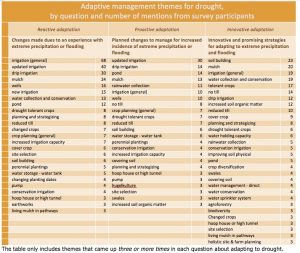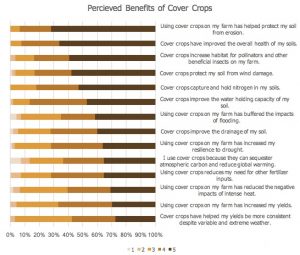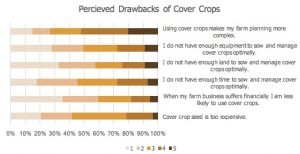Final report for GNE17-163
Project Information
Vegetable and berry farms in the Northeast experience new levels of damage and stress from the increased incidence of drought and heavy precipitation events associated with climate change in the region. This project applied a participatory action research approach to engage farmers in creating context specific information about promising adaptation strategies and resources that support farm resilience. In partnership with farmer organizations from Canada to Pennsylvania, the project collected and shared in information in two ways at farmer conferences in the first year. In the first year, we conducted a survey about adaptation to extreme precipitation events, and in the second year we conducted focus groups and farmer-to-farmer sessions about resources that support farm resilience.
The project revealed that most farmers are proactively adapting to extreme precipitation patterns and are keen to learn more from their peers about successful strategies. However, the practices and strategies which are being used to address risks associated with extreme precipitation are a diverse suite of familiar practices applied in new ways. The use of crop insurance to address climate-related risk is surprisingly low, and the majority of farmers believe they lack the technical knowledge and financial capacity to adequately address climate-related risks to their farms.
In the absence of adequate financial security or climate-risk technical assistance, farmers turn to social networks and community-scale emergency financial assistance programs when suffering big losses due to heavy precipitation and drought. Collaborative problem-solving spaces are among the most important resources which farmers really on for learning about innovative ideas to address climate impacts and other emerging stressors. Farmers are eager to learn from their peers and experts about the best strategies for proactively addressing the new levels of risk associated with extreme weather.
This project laid the groundwork for programmatic and research needs that would support increased climate resilience and adaptive management among vegetable and fruit producers in the northeast. Insights from this research can be applied to other regions and contexts, to support research and outreach on agricultural resilience to climate change. Because we framed our research at the level of climate impact and farmer adaptation, we did not experience any conversations clouded by the politicization of climate change.
1. Identify and assess the adaptive strategies already in use by vegetable and berry farmers in Northern New England to address drought and extreme precipitation.
2. Identify promising strategies for managing drought and extreme precipitation on vegetable and berry farms in Northern New England.
3. Assess influences on adaptive farm management decisions, including what sources of information are most influential, the perceived benefits and tradeoffs of adaptive practices, and what weather prediction tools are in use.
4. Analyze and compare adaptive management practices in use across geographic regions within NNE and across farmer network affiliations, and compare this to extant research and literature.
5. Evaluate the perceived benefits and drawbacks of cover crops on vegetable and berry farms in Northern New England, and compare this to recommendations in extant research and literature.
6. Bridge the localized expertise of farmers with science-based expertise, and regionalized outreach experts to identify the information, resources, communication styles and support needed to help farmers adapt to climate change.
7. Apply a farmer’s first approach to research which addresses the climate information usability gap.
The observed increases in extreme weather events experienced by the Northeast region over the last 50 years have put farmers on the front lines of dealing with the impacts of climate change. However, the regional climatic forecasts for the next century and coming decades will exacerbate familiar challenges of variable and extreme weather, and pose a new level of risk in the region which significantly threatens the viability of most farms. Projected increases in heavy precipitation events and droughts are of particular concern to growers.
The significant crop loss experienced by New England farms during the drought of 2016, and flooding of 2012, indicate that most farms are not adequately prepared to deal with these extreme weather events. This project aims to generate practical, usable and accessible information for growers about how to proactively address these risks, and support them in transitions towards sustainability and climate resilience.
Thoughtful and informed approaches to research and outreach on climate change adaptation are critical to addressing the politically charged and dauntingly complex nature of the topic. Stakeholder feedback from the region indicates that farmers are eager to understand how to sustainably manage these climate-related risks, but they need information that is tangible and focused on their local operating context. This project is narrowed to focus specifically on vegetable and berry farms, in order to provide information which will be useful to the unique needs and challenges shared by these farmers. By focusing this research specifically on drought and extreme precipitation, we expect that farmers will be able to relate personally to these impacts, and consequently, the end data will be more useable.
By collecting information across state lines in New England, we hope to address the potential bias of diffusion theory, whereby adaptive practices may be in use within peer groups, but may be different across different peer networks. Using a regional approach will offer potentially new ideas and approaches across state lines, and contribute to advancements in the diffusion of innovation theory and understandings of how emerging innovations are adopted.
This project addresses the needs of growers by 1) providing information about practical strategies to address drought and extreme precipitation, 2) providing information about the innovative approaches used by vegetable and berry farmers across the region, 3) researching and communicating in ways that addresses the climate information usability gap, and 4) evaluating how cover crops contribute to buffering the impacts of drought and extreme precipitation in this region.
This project addresses SARE goals specifically by advancing understandings of how sustainable innovations are discovered, considered, and adopted. The research will directly investigate best management practices for reducing risks associated with climate change that have a documented impact on farm financial viability, natural resources and quality of life for farmers in the northeast.
Cooperators
- (Educator and Researcher)
- (Educator and Researcher)
Research
Phase 1: Regional Survey
In the first year of the project I surveyed 193 vegetable & berry farmers in collaboration with farmer networks in Northern New England. At the close of 2018 I have analyzed the survey data, and commenced a multi-facted outreach strategy to share this information back to the community.
Developing the Survey Instrument
The survey instrument was developed and refined with feedback from 6 academics, 5 farmers and 4 extension professionals. The survey contained open and closed ended questions focusing on the following information: 1) how are farmers managing for those risks, 2) how are farmers planning to manage for those risks, 3) innovative practices farmers have heard about, 4) what factors influence their decision making, 5) perceived trade-offs of promising strategies, 6) where do farmers learn about new management strategies, 7) current farmer networks , and 8) basic demographic, geographic and production information.
I then generated identical digital and paper versions of the same survey through the KoboToobox platform and anchored the digital version of the survey on a UVM website, housed within the Agroecology and Livelihoods Collaborative page.
Data Collection: Farmer Organizations Stabilize the Research-Farmer Interface
I connected with farmer groups and organizations to bridge my research and outreach project to the growing community. I asked each of the collaborating organizations for advice about how to best reach their constituents and have followed the advice of each. For some organizations this has meant bringing my survey to their conference, meeting, or other event while others advised sending out an email solicitation. Some groups recommended both. A team of enthusiastic undergraduate students from UVM were crucial to collecting surveys.
Surveys were collected in collaboration with the:
- New England Vegetable and Berry Growers Association (NEVBGA)
- Maine Organic Farmer and Gardener’s Association (MOFGA)
- Vermont Vegetable and Berry Growers Association (VVBGA)
- Northeast Organic Farmers Association New Hampshire (NOFA NH)
- Northeast Organic Farmers Association Vermont (NOFA VT)
- Community Involved in Sustaining Agriculture (CISA)
- New England Fruit and Vegetable Conference
- Northeast Permaculture List-serv
- Rutland Farmer’s Market
- Maine Fruit Growers List
- Rural Vermont
Participation incentives, such as Bee'sWrap (donated) and chocolate bars, were offered to farmers who were willing to take the survey. Event organizers and extension agents who know about the project have helped encourage attendees to take the survey. Farmers who have taken the survey have all expressed interest in seeing the results of the survey data.
Survey Analysis
Information gathered in the survey was analyzed using both quantitative and qualitative methods. Associations between management strategies and soil type, geography, and farm demographics are being assessed using a regression modelling approach using R. Narrative answers were analyzed for emergent themes using rigorous qualitative methods guided by grounded theory and constant comparative analysis. Qualitative coding was supported by Nvivo software.
Phase 2: Focus Groups & Listening tour
Focus groups sessions in the second phase of this project invited farmers to unpack implications of the survey research and identify the information, resources, communication styles and support needed to help vegetable and berry farmers adapt to climate change. These focus group discussions were guided by questions about which resources are needed by farmers to support climate resilience.
We conducted semi-structured focus group conversations using and IRB approved informed consent process. Conversations were guided by a list of questions, but participants were encouraged to talk about what was most important to them. 9 recorded sessions were conducted between November 2018 and March 2019. Conversations lasted approximately 50 minutes, and ranged in size, with between 7 - 41 farmers at a time. A total of 173 farmers participated. Recordings were transcribed and analyzed for emergent themes using qualitative analysis methods aided by NVivo software.
Objectives #1-3 are addressed in the survey report., which has been thoroughly described and presented in a widely accessible report available in numerous places. New England Adaptation Survey Report1
Demographics of survey respondents:
193 respondents completed the survey. Respondents primarily represented states in the Northeast, plus six responses which came from Canadian provinces. Basic demographic characteristics of the sample differ from national demographic means. We encourage readers not to infer conclusions beyond the sample because it has not been weighted appropriately to represent all growers in the region. The average age of respondents was 46, positioning the sample as younger than the national average age of farm operators, 58.3 in 2012 (USDA NASS, 2012). Our sample also presents itself as more gender balanced than the national statistics for farmers, which was 70% male in 2012 (USDA NASS, 2012). The majority of the sample is comprised of diversified vegetable farmers and primary decision-makers.
Table 1. Demographics of survey respondents
| Average Age | 47 |
| Gender | 54% Male, 44% Female, 2% Other |
| Average total farm acreage in production | 27.6 acres |
| Average years as a decision maker on a farm | 13 years |
| % of participants who grow organic | 45% |
Adapting to Heavy Precipitation & Flooding:
Producers were first asked a multiple-choice question about which strategies and practices they already use to manage for weather related risks (Figure 1). The options which they could select were based on previously conducted surveys and studies in the region. Producers were also asked three open-ended questions about adapting to the increased incidence of heavy precipitation and flooding:
- What changes have you made on your farm because of this experience with heavy precipitation or flooding?
- What changes are you planning to make in the near future which will help you manage for the risk of heavy precipitation or flooding?
- In your opinion, what is the most promising, interesting or innovative strategy for adapting to heavy precipitation and flooding that you have heard about?
The responses to these questions were analyzed by our research team and then grouped into themes (table 2).
72% of participants have made changes on their farm because of an experience with, or concern about, heavy precipitation or flooding
61% of participants are planning to make changes that will help manage for the risk of heavy precipitation or flooding
Figure 1. Responses to multiple choice question about managing for risk of heavy precipitation and flooding. Table 2. Themes from open-ended questions about heavy precipitation and flooding
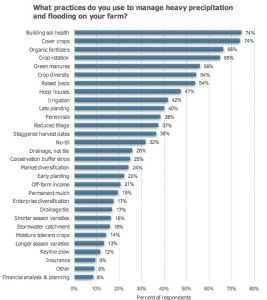
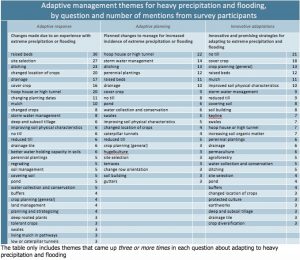
Adapting to Drought:
Producers were first asked a multiple-choice question about which strategies and practices they already use to manage for weather related risks (figure 2). The options which they could select were based on previously conducted surveys and studies in the region. Producers were also asked three open-ended questions about adapting to the increased incidence of drought:
- What changes have you made on your farm because of an experience with drought?
- What changes are you planning to make in the near future which will help you manage for the risk of drought?
- In your opinion, what is the most promising, interesting or innovative strategy for adapting to drought that you have heard about?
The responses to these questions were analyzed by our research team and then grouped into themes (table 3).
66% of participants have made changes on their farm because of an experience with, or concern about, drought.
39% of participants are planning to make changes that will help manage for the risk of drought.
Figure 2. Responses to multiple choice questions about drought risk management. Table 3. Themes from open-ended questions about adapting to drought.
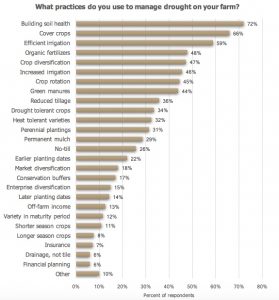
Information Sources:
Vegetable and berry growers in the northeast identified other farmers, university extension and conferences as the best places to look for information on innovative and adaptive approaches to new challenges.
Table 4. Farmers responses to the question: In your experience, what are the best sources of information on innovative and adaptive approaches to new challenges you encounter on your farm?
| Other farmers | 88% |
| University Extension | 62% |
| Conferences | 59% |
| Personal experience & innovation | 53% |
| Farmer organizations | 42% |
| Books | 42% |
| NRCS | 29% |
| Social media | 24% |
| Magazines | 23% |
| Websites | 23% |
| Internet videos | 22% |
| Seed companies | 21% |
| List-servs | 20% |
| Family & friends | 18% |
| State department of agriculture | 16% |
| Scientists | 16% |
| Other agricultural advisors (not extension) | 16% |
| Agricultural supply businesses | 12% |
| Peer reviewed journals | 8% |
| Other | 8% |
| USDA Climate Hubs | 4% |
Objective #4. Using a logistic regression approach, we were able to evaluate how network affiliation and geography influenced the adoption of adaptation practices. The adoption of emerging and innovative climate adaptation practice is significantly influenced by farmer network affiliation. Geographic variables did not have significant influence on adoption.
Objective #5. 88% of survey respondents said they use cover crops. Overwhelmingly, farmers believe that cover crops help buffer or reduce risks associated with extreme precipitation patterns and climate change (figure 3). Some farmers believe that there are drawbacks to cover crops (figure 4).
Figure 3. Perceived benefits of cover crops. Participants were asked to indicate their level of agreement with the following statements on a scale of 1-5, where 5 represents “strongly agree” and 1 represents “strongly disagree”. In the figures below, the darker colors below represent stronger levels of agreement
Figure 3. Perceived drawbacks of cover crops. Participants were asked to indicate their level of agreement with the following statements on a scale of 1-5, where 5 represents “strongly agree” and 1 represents “strongly disagree”. In the figures below, the darker colors below represent stronger levels of agreement
Objectives #6 & 7 culminated in focus groups and participatory analysis of resources for resilience with 173 farmers. We used an asset-based approach to understand and analyze resilience together. Our findings from this part of the project are shared in multiple formats. Important insights include the following:
- The majority of farmers reported that although they understand the vulnerability of their farm to climate change, they lack the informational and financial assets to invest in adaptive management.
- Farmers primarily invest in the natural capital and built infrastructure of their agroecosystem to resist, respond to and prepare for extreme weather risks.
- When extreme weather impacts are big enough to cause severe loss and damage, farmers turn to financial safety-nets and community relationships to help them recover.
- To support their resilience, farmers asked for more on-farm technical assistance to help plan for excessive water issues, peer-to-peer learning opportunities, reliable local markets and financial support for catastrophic losses.
- Farmers highly value NRCS establishment cost-share programs, and would like to see similarly structured programs that support climate adaptation.Governmental and provincial cost-sharing programs were highly cited as important to supporting capacity to adapt to and rebound from weather impacts.
- Farmers cited collaborative problem-solving opportunities as one of the most important ways they address emerging challenges like climate change.
- Discussion revealed a need for guidance on navigating insurance and financial support sources for losses due to extreme weather impacts.
- Farmers expressed a high level of interest in the potential to be paid for ecosystem services and participate in carbon markets.
The results of our research offer important insights for farmers and extension professionals who seek to support agricultural sustainability in the face of climate change.
- Farmers in the Northeast are actively managing for, adapting to and planning for extreme weather events.
- More than 60% of respondents reported using cover crops and soil heath strategies to manage for the risks
- of heavy precipitation and drought.
- There are many emerging, innovative and promising ideas which farmers are using, thinking about and testing.
- Understanding of the flow of water on a site and using a whole systems perspective on farm planning informs long-term adaptation to drought and heavy precipitation.
- The site and soil characteristics of a farm influence some of the adaptive management strategies a farm uses. The survey results reflect this with statistical significance.
- Adaptive management strategies for heavy precipitation and flooding highlight the use of raised beds, investments in storm water management, adjusted locations of crops based on site and soil characteristics, new high tunnels, perennial plants, reduced tillage, and soil building.
- Adaptive management strategies for drought highlight the importance of water harvesting, efficient irrigation systems, mulch, soil health, reduced tillage, and crop planning.
- The climate change impacts which farmers are most concerned about are unpredictable spring temperatures, increased incidence of drought, new pest and disease pressures, and loss of nutrients due to heavy and abundant precipitation.
- Most farmers are confident that they understand the vulnerability of their farmland to extreme weather conditions, yet the majority of growers believe that they do not have the financial capacity, knowledge or technical skills to deal with the expected level of weather-related threats to the viability of their farm operation.
- The majority of farmers reported that although they understand the vulnerability of their farm to climate change, they lack the informational and financial assets to invest in adaptive management.
- Farmers primarily invest in the natural capital and built infrastructure of their agroecosystem to resist, respond to and prepare for extreme weather risks.
- When extreme weather impacts are big enough to cause severe loss and damage, farmers turn to financial safety-nets and community relationships to help them recover.
- To support their resilience, farmers asked for more on-farm technical assistance to help plan for excessive water issues, peer-to-peer learning opportunities, reliable local markets and financial support for catastrophic losses.
- Farmers highly value NRCS establishment cost-share programs, and would like to see similarly structured programs that support climate adaptation.Governmental and provincial cost-sharing programs were highly cited as important to supporting capacity to adapt to and rebound from weather impacts.
- Farmers cited collaborative problem-solving opportunities as one of the most important ways they address emerging challenges like climate change.
- Discussion revealed a need for guidance on navigating insurance and financial support sources for losses due to extreme weather impacts.
- Farmers expressed a high level of interest in the potential to be paid for ecosystem services and participate in carbon markets.
Education & Outreach Activities and Participation Summary
Participation Summary:
Research findings from this project are presented in multiple formats and multiple channels to maximize contact with stakeholders. Partnering with existing outreach channels that are trusted and familiar to farmers ensures that the information generated in this project is delivered effectively to farmers.
Adaptation Survey Report
A report based on the findings of the regional survey conducted in phase one of the project has been completed and circulated through many channels and networks, including directly emailing it to farmers who took the survey, farmer networks, NRCS list servs. The report is available permanently on the SARE projects website, and is also housed on the UVM Extension Center for Sustainable Agriculture website, the UVM Agroecology and Livelihoods Collaborative website, and on the project blog. It has been downloaded 612 since we started tracking that. The report has also been placed in Researchgate and has been read 125 times there, likely by primarily academic and extension audiences. It has been cited three times by other publications.
Websites, Blog Posts & Newsletters
The project blog (https://adaptationsurvey.wordpress.com ) has received 997 views to date. Blog posts have also been posted related to the project on the UVM Extension Center for Sustainable Agriculture website, the UVM Agroecology and Livelihoods Collaborative website. Also, the report based on the survey results was featured in the November 2018 SARE Innovations web-based email. NRCS in Vermont and Pennsylvania have also circulated the survey report via email lists.
Direct Contact & Tabling at Farmer Events
The table which I used to solicit survey responses in the first year included outreach materials about climate resilience provided by the UVM Center for Sustainable Agriculture and the USDA Northeast Climate Hub. This includes a collection of about 10 briefs and case studies that are available for visitors to take with them. We also have a tablet on the table which displays the UVM Center for Sustainable Agriculture's recent video series of farmers in New England telling stories about how they are adapting to the increases in extreme weather. The USDA Northeast Climate Hub's web-based "As if you were there" adaptive management visualizations are also viewed by visitors on the tablet. Farmers and advisors who visit the table interact with these materials and engage in conversations about the topic. Many expressed gratitude for the work and interest in the results, and noted the general lack of resources and conversation about the topic elsewhere. Each farmer who has taken the survey has been exposed to the outreach materials and engaged in thinking about adaptive management strategies.
I have also tabled at farmer conferences in the second year to distribute the survey report back to farmers.
Webinars
- NH Food Alliance recorded a webinar on 11/21/2019 which summarizes the key findings from both phases of my project. https://www.youtube.com/watch?v=aXBwyVtcngY or https://www.nhfoodalliance.com/content/past-webinars
- The UMaine/USDA GradCap program recorded a webinar presentation based on the survey in October 31, 2018. Located here: https://www.climatehubs.oce.usda.gov/hubs/northeast/events/gradcap-webinar-farms-and-farmer-decisions
Podcasts
- Yale Climate Connections Feature: https://www.yaleclimateconnections.org/2019/11/many-farmers-feel-unprepared-for-increasingly-extreme-weather/
- Interview with the Eastern New York Veg Podcast from Cornell University Cooperative Extension
Features in local, national and international press:
Vermont
- VPR Cafe: A Change In Climate Calls For A Change In Farming
- In Vermont's Seven Days: "Vermont Farmers Learn to Adapt to a Changing Climate "
- https://jerichovermont.blogspot.com/2019/11/climate-change-and-local-farms-jericho.html
National
- Acres USA feature article in September 2019 "A Change in the Weather: Climate Change Wallops U.S. Farms"
- A brief mention in the New York Times
- https://www.lancasterfarming.com/farm_life/conservation/farmers-climate-adaptation-vital/article_669fd1e9-c398-5a27-ac5f-b93179bf4ded.html
- "How farmers can fight climate change" in Eco Farming Daily
International
Completed Presentations:
- NOFA VT Winter Conference, Soil Health Policy Panelist, February 2020
- NH Food Alliance Summit, invited speaker, March 2020
- "Climate Change Effects on Local Farming” panel discussion hosted by Transition Town Jericho, November 18, 2020 in Jericho VT. I've included a picture of farmers on the panel; David Zuckerman of Full Moon Farm in Hinesburg who is also Lieutenant Governor of Vermont; myself; John Hayden of the Farm Between in Cambridge, S'ra Desantis for UVM Farmer Training Program and Tucker Andrews of Notch Farm in Jericho.
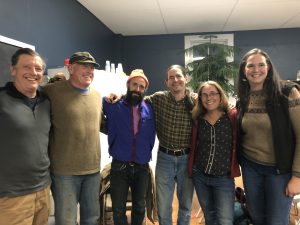
- Panel/forum hosted by the Windsor County Farm Bureau in Hartland VT titled "FORUM ON CLIMATE AND AGRICULTURE: Challenges & Opportunities", on November 20th, 2020 : https://www.youtube.com/watch?v=yGAYpOFlC8w&feature=youtu.be
- New England Vegetable and Fruit Conference Dec 10-12 2019
- Northeast Specialty Crop Water Symposium Dec 18-19 2019 NOFA MA winter conference
- MOFGA Farmer-to-Farmer Conference. Nov 3-5, 2018 Northport, ME
- ACORN Annual Conference Nov 26-28, 2018 Charlottetown, PEI Canada
- NOFA MA Winter Conference, Jan 12, 2019 Worcester, MA
- NOFA NY Winter Conference. Jan 18-20, 2019 Saratoga Springs, NY
- PASA (Pennsylvania Association of Sustainable Agriculture) Conference Feb 6-9, 2019 Lancaster, PA
- NOFA VT Winter Conference. Feb 16-18, 2019 Burlington VT
- NOFA NH Winter Conference, March 16th, Manchester NH
- American Association of Geographers annual meeting, April 3 2019, Washington DC,
- USDA Northeast Climate Hub University Network Meeting on March 14th, 2018.
- Our Farms, Our Future, SARE National Conference in St. Louis MO, April 2018 (poster)
- UVM Student Research Conference, April 2018 (oral presentation and poster)
- UVM Department of Plant & Soil Science seminar series, November 2018
- “Bridging the Climate Information Usability Gap in Agricultural Communities.” American Meteorological Society's 98th American Meteorological Society Annual Meeting, January 8th 2018, Austin TX
Research Briefs & Scholarly Articles:
Research results are intended to be presented in accessible research brief formats and longer narrative analyses, including:
- A full report based on the survey results in year 1 (complete)
- A shorter research brief summary/fact sheet with the survey results from year 1 (complete)
- A research brief based on the results of the focus groups in year 2 (forthcoming)
- Two academic papers have been completed based on analysis of the survey data, and constitute my MS thesis. These two papers are being edited by UVM faculty co-authors and will be submitted for publication to scholarly journals in the coming month.
- A third academic paper which explores the role of farmers networks in supporting the adaptive capacity of farmers, which has been invited for submission to the journal Elementa.
- A fourth paper on the results of our focus groups is in prep
Undergraduate Education:
- I mentored four undergraduate students who have volunteered and interned with the project thus far. They are passionate about sustainable agriculture and supporting farmers.
Project Outcomes
Our project directly influenced the level of comfort and conversation about climate change among the vegetable and fruit growing community in the northeast. Organizers have personally told me that our project presence at conferences helped them be comfortable in conversations about climate change, where they had previously worried it was too politically charged to directly address. When we first went to conferences, farmers thanked us for bringing up climate-impacts because no one else was talking about it. Three years later, there are many climate-related sessions at conferences.
The survey results are an important reference point for farmers, extension professionals and researchers on climate resilience and agricultural adaptation. The survey report has been downloaded from the project website in 10 different countries, a total of 612 times.While we did not collect a formal impact survey from the farmers who participated in the project because the community was so big and broad, we have heard from many farmers who reported using our research to inform their planning, and their advocacy to their representative.
The research touches on many aspects of sustainability, but more so on the environmental and social ones. In terms of environmental benefits, most of the practices that were mentioned by farmers have environmental benefits in addition to helping adapt production on-farm. In terms of social benefits, the research points towards the importance of farmer networks, farmer to farmer knowledge exchanges and boundary organizations that support this. More research is needed in terms of on-farm economic challenges and responses to climate change adaptation, although this project points towards some of the practices that could be analyzed in more detail from a financial perspective.
The survey data has unearthed a trove of on-farm research projects which are needed to assess the mechanisms by which adaptive strategies actually interact with precipitation trends.
One of our big discussions has been about the way farmers answered our question about which strategies are most innovative and promising. The major trends in responses to this question are not about new ideas, but highlight the way strategies that are already in the toolbox of growers are considered innovative and promising. We think its that the innovation is not in the practice itself, but the way its applied to address a new challenge.
One of my advisors wrote, "I began to understand how widespread farmer interest was in knowing/understanding what practices were being used by others to adapt to climate change in the region. This interest was encouraging, and changed my perceptions about farmer concern with the impacts of climate change. I also found the level of adaptation by farmers to be surprising, based on my conversations and observations. The results of the study were also encouraging in this regard, and indicate that our outreach efforts should put more focus on understanding what is currently being implemented by farmers and enhancing communication of that to other farmers."
Another advisor wrote, "It was very interesting to see both the knowledge on practices that farmers have gained and are applying to address climate change, as well as their desire to learn more from each other. This supports the notion that we need to invest in projects that incorporate farmers as active participants in research and knowledge co-creation."
My advisors have noted their surprise in the extent to which farmers have been willing to talk about climate change, even among more conservative and conventional communities. Farmers are ready and waiting for researchers to catch up on this topic. Funding from the USDA Northeast Climate Hub has been secured to support my time and costs of the expanded geographic scope of the project and outreach activities into the second year.
I heard enthusiasm from farmers about hearing the results of my research project, and am passionate sharing it back with them. I think its really important to ask farmers about what matters to them, and to take the time to listen. This task of drawing out the perspectives of farmers and then sharing it back to the community is something I enjoy and have been sought after to do for other projects. I am now involved in a 2 year project with the Center for Sustainable Agriculture at UVM which looks at complimentary research questions. My role in this project will be to draw in the voices of farmers through focus groups and interviews, and I hope to serve in this facilitation/communication role in the coming years.
This project was designed around collaborating with farmer groups to administer a large survey and then conduct focus groups across the region. The approach has been successful in some ways, but poses new challenges. By working directly with farmer networks, the conversation generated by this research has already been immediately inserted into programming and proposals by some of the collaborators.
The first major challenge has been how time intensive the communication and travel aspects of this approach are. I vastly underestimated the amount of effort which would be required on my part to conduct each part. For those who look to this as a model, I suggest you have a team of students to share the load, and find additional ways to support your time.
The second major challenge has been the number of other surveys which co-occurred with this project. A large NASS survey was conducted the same winter and I had colleagues from UVM who started to come to events because I reported my success in tabling for survey responses. Extension and farmers both mentioned that folks were feeling "over-surveyed." I think it will be important for researchers and farmer groups to streamline or limit the surveys posed to farmers in each season.
Overall, I am very glad to have had so much direct contact growers and offered a consistent presence at farmers' meetings. This grounded my perspective in the current concerns and conversations of farmers, and made sure that the farming community is aware of the project.
Information Products
- Poster: Linking adaptive management to climate change impacts on diversified vegetable and berry farms in northern New England (Conference/Presentation Material)
- New England Adaptation Survey Report (Bulletin, Decision-making Tool, Fact Sheet, Manual/Guide)
- Poster: Adaptation and Resilience on Vegetable and Fruit Farms in the Northeastern US (Conference/Presentation Material, Display)
